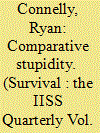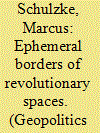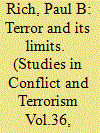| Srl | Item |
| 1 |
ID:
116644


|
|
|
|
|
| Publication |
2012.
|
| Summary/Abstract |
It seems unlikely that a statesman like Georges Clemenceau could be elected in the West today. The son of a political activist, Clemenceau was sent to Paris for an education in medicine, but quickly became immersed in radical politics. He wrote for and founded several journals that attacked the regime of Napoleon III. He served one 73-day stint in prison, decided that was enough, and sought refuge in America just after he received his medical licence. He returned to France after its loss in the Franco-Prussian war, participated in the Paris Commune, and was one of the intellectual leaders of the movement to revenge the loss to Germany known as revanchisme. Early on, he was nicknamed 'Le Tigre' after his fierce style of debate, a reputation that followed him all the way to the office of prime minister.
|
|
|
|
|
|
|
|
|
|
|
|
|
|
|
|
| 2 |
ID:
111645


|
|
|
|
|
| Publication |
2012.
|
| Summary/Abstract |
From the Paris Commune to the Red Shirt uprising in Bangkok, revolutionaries lacking the power to overthrow their states or depose unpopular politicians have captured parts of major cities and formed their own temporary enclaves of resistance. These groups create intraurban borders by building barricades, arming themselves, and fighting to protect their space. The borders, while temporary and usually ineffective, are powerful symbols as they separate a sphere of active resistance from territory under state control. While these borders stand, they are challenges to state power - lines marking the limits of what states can control. This essay looks at how these borders arise and how they relate to more familiar types of borders. Revolutionary borders are shaped by many of the same forces as national borders, most notably globalisation, but have a distinct character that is closely linked to the changing geography of urban areas.
|
|
|
|
|
|
|
|
|
|
|
|
|
|
|
|
| 3 |
ID:
124538


|
|
|
|
|
| Publication |
2013.
|
| Summary/Abstract |
This article argues that much of the historical analysis of terror and terrorism in history has been weak in understanding the limits on terrorist activity and how terrorist campaigns eventually end. Reviewing three recent studies that examine various aspects of terrorism and the language of terror, the article seeks to show that states often play a major role in the way terrorist movements develop and eventually end up either defeated or moving into mainstream political engagement. The article points to a number of examples to illuminate this including the Carbonara in nineteenth century Italy, the Paris Commune and the ending segregation in the U.S. South in the 1960s.
|
|
|
|
|
|
|
|
|
|
|
|
|
|
|
|